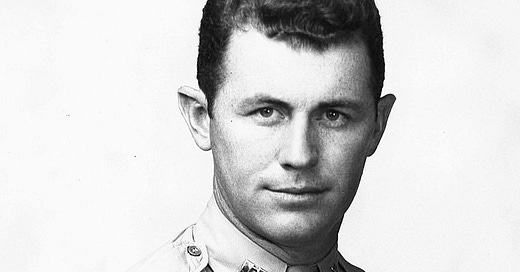Chuck Yeager becomes an ace in a day
On Oct. 12, 1944, the Associated Press moved a two-paragraph story from London that was printed in a few dozen newspapers back home:
Four Luftwaffe fighter planes went down over Hannover, Germany, Thursday before the flaming guns of Lt. Charles E. Yeager, Hamilton, W. Va., who a few days ago went to General Eisenhower personally asking permission to return to combat.
Yeager, who was wounded over Berlin last March, dived into two Germans so fiercely he made them bail out, crashed a third into the ground and the fourth plane came apart while the pilot was snap rolling in an effort to escape the West Virginian’s wrath.
The following day, the AP sent a two-paragraph update noting that Yeager’s total for the day had been upped to five after fellow pilots reported seeing him down an additional German fighter.
The 21-year-old Yeager, who had joined the Army Air Forces three years earlier as a mechanic, already had two victories to his credit before the dogfight that officially made him an ace.
Details of the encounter didn’t emerge until the following spring, when the Army Times wrote about Yeager convincing Eisenhower to allow him to rejoin the fight. Yeager had been shot down on March 5, 1944, but managed to make his way into Spain via an escape line.
Regulations at the time forbade airmen who had used those systems to escape from returning to fight in the same theater because of the risk that they might compromise the escape lines under interrogation if they were captured. Less than a week after D-Day, though, Yeager and another pilot prevailed on the Supreme Commander to allow them to return since much of the French resistance had come out into the open since the Normandy invasion.
That led to the events of Oct. 12, when Yeager led a flight of P-51s from the 357th Fighter Group on an escort mission over Germany. Yeager spotted nearly two dozen Me-109s near Bremen and ordered his men to attack. From the Army Times story:
His first swift, bold pass caused two Nazi pilots to bail out of their aircraft before the Mustang pilot opened his guns on them.
Closing up to 600 yards on two more German planes, he opened fire. One of the enemy planes skidded off to the left, smoking, and went crashing into the ground. The flier’s bullets ripped into the next one and sawed the fuselage in half. The 109 exploded in mid-air. Still persistently after the Germans, Yeager pursued and shot down his fifth victim after a chase from 28,000 to 18,000 feet.
Yeager’s group scored eight victories on this mission and the bombers were unmolested to drop their loads on the Reich.
Yeager was awarded the Silver Star for his efforts and added an oak leaf cluster six weeks later when he nearly duplicated the feat, claiming four more victories — all of these against Fw 190s — in a massive aerial encounter over Germany on Nov. 27.
In between, on the morning of Nov. 6, Yeager shot down an Me 262 as it approached an airfield to land, making him one of the first pilots to take out the German jet fighter.
Yeager continued flying through mid-January 1945 before returning to the U.S., where he eventually became a test pilot. His exploits in that arena would soon make him a household name.
On Oct. 14, 1947 — nearly three years to the day after he first generated headlines — Yeager officially became the first person to break the sound barrier in level flight.
The Air Force would not officially confirm that news until the following June, but on Dec. 22, 1947, Aviation Week and the Los Angeles Times published lengthy stories about the historic flight of the Bell XS-1 over the California desert, naming Yeager as the pilot.




